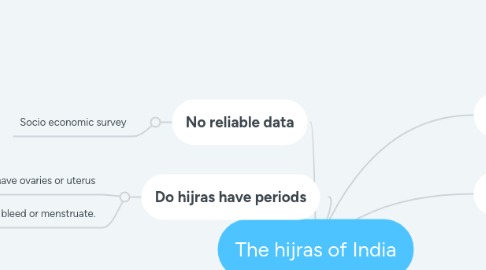
1. How many types of hijras are there
1.1. The term Hijra is an umbrella term which includes various forms of gender deviances.
1.2. They include true hermaphrodites, transgender/cross-dressers, homosexuals, bisexuals, and fake Hijras.
1.3. In the studied area as well as in India the Hijras are mainly classified into five gender categories.
2. Do hijras have periods
2.1. As they are assigned male at the time of their birth, trans woman does not have ovaries or uterus
2.2. During menstruation the lining of the uterus shed and bleed, since there is no uterus, trans woman do not bleed or menstruate.
3. Transgender rights
3.1. Self declared identity
3.1.1. No district Screening Committee
3.1.2. No expert / medical / psychological assessment
3.1.3. Gender autonomy
3.2. Dignity
3.3. Healthcare
3.3.1. Counselling
3.3.2. Free gender transition surgery
3.4. Respect
3.5. Anti discrimination
3.5.1. Adjudication
3.6. Hijra garanas
3.6.1. Badhai
3.6.2. Mangti
3.6.3. Guru chela
4. No reliable data
4.1. Socio economic survey
5. Some eunuchs did marry and adopt children (and a few had wives and children from before their operation) but were cut off from the usual support systems. It was a life Sun Yaoting knew only too well
6. Neither man nor women
6.1. The body structure of hijras
6.1.1. Typically, hijra are born with male genitalia, though some are intersex (born with hybrid male/female sex characteristics). Most hijras elect later in life to surgically remove the penis and testicles.
6.2. Who are hijras in India
6.2.1. The hijra (eunuch/transvestite) is an institutionalized third gender role in India
6.2.2. Hijra are neither male nor female, but contain elements of both, As devotees of the Mother Goddess Bahuchara Mata
6.2.2.1. their sacred powers are contingent upon their asexuality. In reality, how- ever, many hijras are prostitutes.
7. When did hijras start
7.1. The Hijra community has been mentioned in ancient literature, the most known of which is the Kama Sutra, a Hindu text on human sexual behavior written sometime between 400 BCE and 200 CE.
7.2. Hijra characters hold significant roles in some of the most important texts of Hinduism, including the Mahabharata and the Ramayana
8. Can they marry
8.1. Eunuchs were expected to show complete devotion to their duties, and to their masters and mistresses.
9. Rights
9.1. Differentiated equality
9.1.1. Recognition
9.1.2. Reservation
